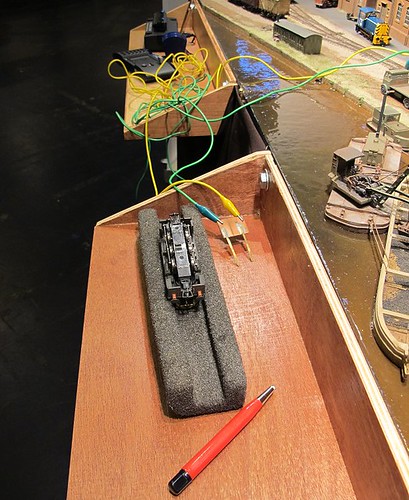Wheel cleaning under DC
- Place loco upside down in Peco cradle
- Attach flyleads to the back of a controller
- Hold leads against wheels
- Hold fibre pen on each wheel in turn
- Wait for a few moments and shiny metal is revealed
- Take loco away and repeat
Wheel cleaning under DCC
- Place loco upside down in Peco cradle
- Realise you can't attach flyleads to the back of the controller
- Try to find a spot where you can clip them to the track and not destroy some detail
- Work out which number loco you are cleaning
- Dial up the number on the keypad
- Turn up controller
- Realise you've dialed up the wrong number
- Dial up the correct number
- Hold leads against wheels
- Hold fibre pen on each wheel in turn
- Wait for a few moments and shiny metal is revealed
- Take loco away
- Place next loco in cradle
- Realise you can't remember the number
- Decide that the wheels aren't that dirty anyway

3 comments:
Carefull now Phil, don't you know that DCC, along with Static Grass and 3D Printing, forms the New Modelling Religion?
I note that its now possible to control your locos from your phone. Perhaps theres a wheel cleaning app on the horizon...
This stuff is only likely to work if you can remember what number your controller calls your loco.
I don't know for sure - but it's possible that any "loco controller" Android apps might allow for locos to be selected using avatars (which could, perhaps, be photos).
I'll admit to not really being a fan of DCC, static grass or 3D printing. I'm interested from a technical angle - what's involved - what makes them tick - what the results are like - that sort of thing. However, I'm not planning on buying any of this stuff any time soon.
Despite this, if I build any new model locos, railbuses, or whatever, I'm likely to fit a DIY 8 pin DCC socket. However, there is a reason for this apparent madness.
Running all the wiring in a loco through a neat, standardized, plug / socket arrangement like this is likely to make faultfinding / maintenance easier than it might otherwise be. It allows different bits to be isolated, while I run a digital multimeter over it or do other checks. Colour coding of wiring also helps - as long as a standard colour code is used.
In other words, I'll happily use the bits of DCC that work for me - but I'll give the rest a miss. I hope I haven't upset anyone - but DCC isn't really for me.
Hi Phil, unless you've specifically disabled dc compatability then cleaning is identical for both. Just do the same to the DCC loco as for a DC one. Unless you've not brought a DC supply... If that's the case it's useful to have a bridge rectifier at the ends of the croc cables. Then just connect to the track and go as DC. Hope that helps. Luke
Post a Comment